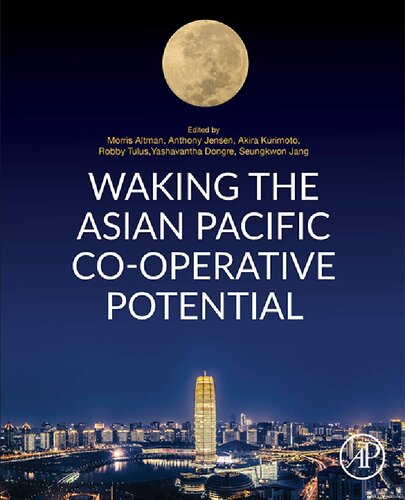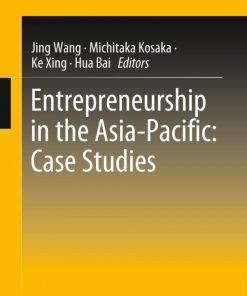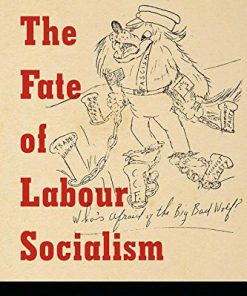Waking the Asian Pacific Co operative Potential 1st Edition by Morris Altman, Anthony Jensen, Akira Kurimoto, Robby Tulus, Yashavantha Dongre, Seungkwon Jang ISBN 9780128166666 0128166665
$50.00 Original price was: $50.00.$25.00Current price is: $25.00.
Waking the Asian Pacific Co-operative Potential 1st Edition by Morris Altman, Anthony Jensen, Akira Kurimoto, Robby Tulus, Yashavantha Dongre, Seungkwon Jang – Ebook PDF Instant Download/Delivery: 9780128166666, 0128166665
Full download Waking the Asian Pacific Co-operative Potential 1st Edition after payment

Product details:
ISBN 10: 0128166665
ISBN 13: 9780128166666
Author: Morris Altman, Anthony Jensen, Akira Kurimoto, Robby Tulus, Yashavantha Dongre, Seungkwon Jang
Replete with case studies, Waking the Asian Pacific Cooperative Potential applies a novel theoretical framework to aid in understanding meaningful change in cooperative firms, mutual firms, collectives, and communes, focusing in particular on the underexamined Asia Pacific region. It explores the common, albeit competing, objectives of transformational cooperatives that deliver a range of social benefits and corporative coops where the cooperative exhibits the characteristics of a competitive investor firm. The book provides examples of successful cooperatives in eleven countries across the Asia Pacific and reviews the theoretical framework of cooperatives, including issues pertaining to socio-economic, politico-legal, and domestic and international factors.
Waking the Asian Pacific Co-operative Potential provides early-career researchers and graduate students with a systematic resource of cooperatives in the Asia Pacific, highlighting core lessons from case studies regarding the ideal role of cooperatives in a modern economy and on the enabling factors of the role of the state, the market potential for scale-up, the mitigation of poverty, and civil society.
Table of contents:
1. Introduction
1.1 Cooperatives in the transforming Asian Pacific region
1.2 Waking the Asian Pacific cooperative potential
1.3 Structure of this book
1.4 Creating the Asian Pacific scholarship on cooperative studies
Part 1: Analytical Framework of Asian Cooperative Models
2. Why Asian Pacific Cooperative Models Matter?
2.1 Introduction
2.2 Asia Pacific region’s vast diversity
2.3 Emergence of Asian Pacific cooperative models
2.4 Inter-cooperation as another Asia Pacific cooperative model
2.5 Conclusion
3. Are There Core Cooperative Principles Required for Cooperative Economic Success and Sustainability?
3.1 Introduction
3.2 Cooperative principles and values in context
3.3 Cooperative principles and values: international cooperative alliance
3.4 What is a cooperative?
3.5 Values
3.6 Democracy
3.7 Surpluses
3.8 Autonomy and independence
3.9 Education
3.10 Noncore differentiating attributes and the cooperative advantage
3.11 The cooperative advantage
3.12 The long and the short run
3.13 Incompatible attributes revisited
3.14 Indian cooperatives
3.15 Conclusion
4. Emerging Asian Pacific Cooperative Models from a Global History Perspective
4.1 Introduction
4.2 Origin of Asia Pacific cooperatives in the late 19th and early 20th century
4.3 Evolution of Asia Pacific cooperative models after the Second World War
4.4 Changing mode of exchange: from unilateral assistance to mutual learning
4.5 Conclusion
5. Asian Cooperatives and Public Policy
5.1 Introduction
5.2 Colonial legacy and cooperative legislation in Asia
5.3 Failed government top-down approaches in cooperative development: three case studies
5.4 Public policy initiatives of the International Cooperative Alliance
5.5 Sustaining the momentum of public policy debates on cooperatives
5.6 Conclusion
6. Cooperatives and the Sustainable Development Goals
6.1 Introduction
6.2 Sustainable development
6.3 Background to the Sustainable Development Goals
6.4 Cooperatives and sustainable development
6.5 International Cooperative Alliance and the Sustainable Development Goals
6.6 Asia Pacific cooperatives implementing the Sustainable Development Goals
6.7 Issues and challenges for cooperatives
6.8 Conclusion
7. Asian Cooperatives and Gender Equality
7.1 Introduction
7.2 Rationale for gender equality in the cooperatives
7.3 Challenges to the advancement of gender equality in cooperatives in Asia
7.4 Contribution of Asian cooperatives to gender equality
7.5 Conclusion
Cooperatives and Youth in Asia
8.1 Introduction
8.2 Profile of youth population in Asia Pacific region
8.3 Challenges faced by youth
8.4 Why cooperatives are ideal platforms for youth
8.5 Why cooperatives need youth participation
8.6 Campus cooperatives: the Asian model of youth integration
8.7 Role of ICA Asia Pacific
8.8 Conclusion
9. The Theoretical Model of Asian Capitalism and the Varieties of Cooperation
9.1 Introduction
9.2 Toward a theoretical model for Asia Pacific
9.3 Conclusion
Part 2 Case Studies of Asian Cooperatives, Including Cross-Country Comparison
Section 1: Agricultural Co-ops
10. How Small Farmers Enter the Big Market? A Case Study of Agricultural Cooperatives in China
10.1 Introduction
10.2 Case study
10.3 Further thinking
10.4 Conclusion
11. Successful Agricultural Cooperative Model in Vietnam: A Case Study of Van Duc Co-operative
11.1 Overview
11.2 Macro factors affecting cooperatives in Vietnam
11.3 Micro factors affecting cooperatives in Vietnam
11.4 Characteristics of the Van Duc Co-operative
11.5 Challenges faced by Van Duc Co-operative
11.6 Factors contributing to success
11.7 Impacts
11.8 Conclusion
12. Cooperatives: A Panacea for Rural Population
12.1 Introduction
12.2 Section I
12.3 Section II
12.4 Section III
13. Korea’s Multipurpose Agricultural Cooperatives and the Developmental State: The Case of the National Agricultural Cooperative Federation (NACF)
13.1 Introduction
13.2 The early stage of National Agricultural Cooperative Federation from 1961 to 1980
13.3 Challenges to National Agricultural Cooperative Federation
13.4 Responses for the betterment of National Agricultural Cooperative Federation
13.5 Conclusion
14. Nepal Multipurpose Cooperative Society Limited
14.1 Brief history of cooperatives in Nepal
14.2 Nepal Multipurpose Cooperative Society Limited
14.3 Nepal Multipurpose Cooperative Society Limited: a successful cooperative
14.4 Macro factors contributing to the emergence of cooperatives
14.5 Market functioning and capitalism
14.6 Social movements and cooperatives
14.7 Internal factors leading to success
14.8 Business model and development strategy
14.9 Human resource management
14.10 Cooperative members and financial structure
14.11 Challenges and overcoming measures
14.12 Factors contributing to cooperative failure
14.13 Factors contributing to cooperative success
14.14 Impacts on members and local community
14.15 Conclusion
14.16 Further reading
15. Japan: Cooperatively Facilitating Membership Engagement—Employee-Led Initiatives at JA Hadano
15.1 Introduction
15.2 Emergence
15.3 Governance
15.4 Case study: JA Hadano
15.5 Governance at JA Hadano
15.6 Employee-driven membership engagement initiatives
15.7 Jibasanzu
15.8 Membership education
15.9 Conclusion
16. Almondco: An Australian Cooperative Success Story
16.1 Introduction
16.2 Historical overview
16.3 A cooperative success: Almondco
16.4 A mature democratic business emerges
16.5 Overcoming obstacles to success
16.6 Macro factors
16.7 Micro factors
16.8 Degeneration or staying true to cooperative principles?
16.9 Cooperative principles
16.10 Future challenges
16.11 Lessons to be learned
16.12 Conclusion
17. Agricultural Cooperatives in Asia: State, Market, Governance, and Sustainability
17.1 Introduction
17.2 Case studies
17.3 Legal regime
17.4 Role of state
17.5 Social capital
17.6 Addressing the challenges
17.7 Conclusion
Section 2: Consumer Co-ops
18. The Success of the Saigon Co-op in the Retail Sector of Vietnam
18.1 Introduction
18.2 The socialist republic of Vietnam and its cooperatives
18.3 The foundation of Saigon Co-op
18.4 Organizational structure, management, and business outcomes of Saigon Co-op
18.5 Factors affecting the emergence of cooperatives in Vietnam
18.6 Factors contributing to the success of Saigon Co-op
18.7 Identifying and overcoming current challenges faced by Saigon Co-op
18.8 The impact of Saigon Co-op on Vietnam
18.9 Conclusion
19. NTUC FairPrice Supermarket and Cooperatives in Singapore
19.1 Introduction
19.2 Key cooperatives in Singapore
19.3 Case study: NTUC FairPrice Co-Operative Ltd
19.4 Conclusion
20. Korea’s Consumer Cooperatives and Civil Society: The Cases of iCOOP and Hansalim
20.1 Introduction
20.2 A brief history and the current status
20.3 Categories and structures of Korea’s consumer cooperatives
20.4 The characteristics and the roles of Korea’s consumer cooperatives
20.5 Conclusion
21. Consumer Cooperatives’ Model in Japan
21.1 Introduction
21.2 Overview of Japanese consumer cooperatives
21.3 Japanese consumer cooperative model: Its characteristics
21.4 Macro factors affecting consumer cooperatives’ development
21.5 Micro factors for success
21.6 Impact of Japanese model on members and wider society
21.7 Conclusion
22. Consumer Cooperatives Summary
22.1 Introduction
22.2 Consumer cooperatives in the Asian context
22.3 Legal framework and state policy
22.4 Relationship with social movements
22.5 Micro factors contributing to success
22.6 Challenges facing consumer cooperatives
22.7 Conclusion
22.8 Further reading
Section 3: Credit Co-ops
23. Teachers Mutual Bank Case Study
23.1 Introduction
23.2 Credit Unions and their origin in Australia
23.3 Hornsby Teachers Credit Union
23.4 NSW Teachers Credit Union
23.5 Teachers Mutual Bank
23.6 Conclusion
24. From Resilience to Unlimited Opportunities: The First Community Credit Cooperative’s (FICCO) Experience
24.1 Growth of credit cooperatives in the Philippines
24.2 The start of FICCO
24.3 The FICCO culture
24.4 Further challenges among cooperatives in the Philippines
24.5 Conclusion
25. Existential Challenges of Cooperatives and Credit Unions in Indonesia
25.1 Cooperatives in Indonesia: a historical view
25.2 Cooperatives in the post-independence years
25.3 The emergence and growth of credit unions in Indonesia
25.4 Keling Kumang case study
25.5 Further reading
26. The SANASA Movement—Sri Lanka
26.1 Historical background of SANASA
26.2 Early challenges of SANASA
26.3 SANASA’s growth and development amid continuing challenges
26.4 Growth and development of SANASA’s four pillars
26.5 Future sustainability of SANASA
26.6 Further reading
27. Summary: Credit Union Case Studies
Section 4: Worker Co-ops
28. The Sociopolitical Environment of Worker Cooperatives in the Philippines: Basis for Addressing the Worker Contractualization Issue
28.1 History of worker cooperatives in the Philippines: A case of Alpha Co-operative
28.2 Overcoming challenges during the initial phase
28.3 Macro challenges in the growth phase: The state’s underdeveloped role and weak legal structure
28.4 Micro challenges in the growth phase: The overriding capitalist mentality among worker cooperatives
28.5 Theoretical interpretation
28.6 Conclusion
29. Collectivism as a Strategy for Success in Indian Worker Cooperatives: Case Study of Koppa Transport Cooperative Society
29.1 Workers cooperatives in India
29.2 Transport cooperative society, Koppa
29.3 Challenges and strategies
29.4 Conclusion
30. Successful Cooperatives Across Asia: ULCCS—The Icon of Successful Cooperatives in India
30.1 Introduction
30.2 Genesis of Uralungal Labour Contract Co-operative Society
30.3 Background to the formation of Uralungal Labour Contract Co-operative Society
30.4 Macro factors as a key to emergence and success
30.5 Micro factors as a key to emergence and success
30.6 Conclusion
31. Worker Cooperatives as a Model for Family Business Succession? The Case of C-Mac Industries Co-operative Ltd in Australia
31.1 Introduction
31.2 C-Mac Industries Co-operative Limited
31.3 Overcoming legal obstacles and agreeing on the value of the business
31.4 Methodology: Participatory action research at C-Mac
31.5 Key obstacles to the emergence of the C-Mac cooperative
31.6 Overcoming the financial obstacles
31.7 Overcoming risk aversion
31.8 Overcoming access to financial skills and cooperative expertise
31.9 Success of C-Mac cooperative
31.10 Factors contributing to the success of buyouts
31.11 Conclusion
32. Korea’s Worker Cooperative and Organizational Transformation: The Case of Happy Bridge Co-operative
32.1 Introduction
32.2 Development of Korea’s worker cooperatives
32.3 Becoming a worker cooperative
32.4 Conclusion
33. Workers’ Cooperatives as a Solution to Social Exclusion in Japan
33.1 Introduction
33.2 Contexts of social exclusion
33.3 Two streams of workers cooperatives
33.4 Considerations on the development of workers cooperatives
33.5 Impacts and challenges
34. Summary
34.1 Socialist system—solidarity in job creation
34.2 Post-socialist system—a collective response
34.3 Emerging Southeast Asian system—individual triumph
34.4 Advanced Northeast system—civil society activists for democratizing workplaces
34.5 Liberal corporatist system—the catalyst of civil society movements
34.6 Liberal market economy system—worker buyout of a family business
34.7 Proof of concept
34.8 Scaling up
Part 3: Toward an Asian Scholarship on Co-ops
35. Deconstructing Cooperative Success in the Asia-Pacific Region
35.1 The state and civil society
35.2 Findings through case studies
35.3 Macro factors
35.4 Micro factors
35.5 The Asia-Pacific model
People also search for:
waking the asian pacific co operative potential
the pacific wake up
asian-pacific economic cooperation
jp waking up from a coma
what was the asia pacific war
Tags:
Morris Altman,Anthony Jensen,Akira Kurimoto,Robby Tulus,Yashavantha Dongre,Seungkwon Jang,Waking,Asian Pacific,Co operative Potential
You may also like…
Business & Economics
Co operative Banking Networks in Europe Models and Performance Federica Poli
Uncategorized
Education Studies & Teaching - School Education & Teaching
Politics & Philosophy - Social Sciences
Business & Economics
Politics & Philosophy - Anthropology
Colonialism and Male Domestic Service across the Asia Pacific Julia Martinez
Cookbooks
Politics & Philosophy












